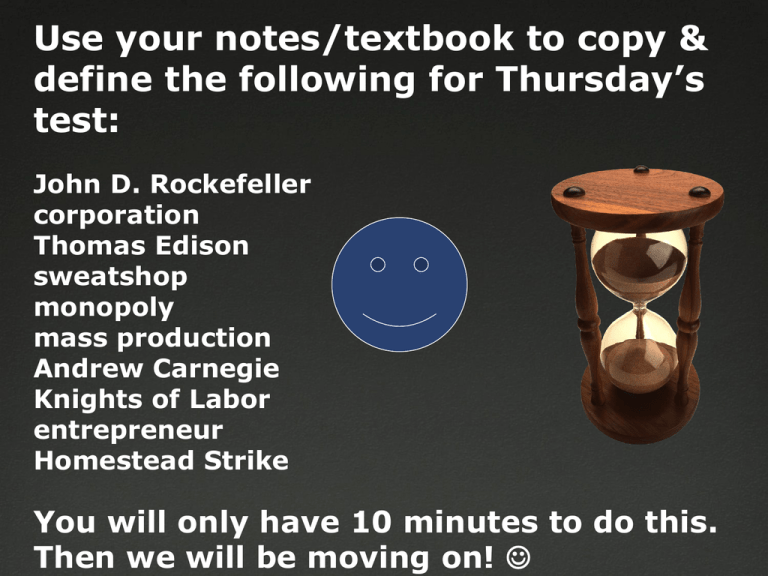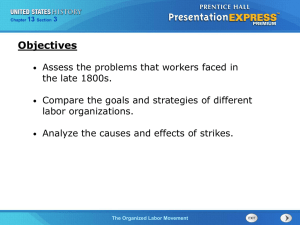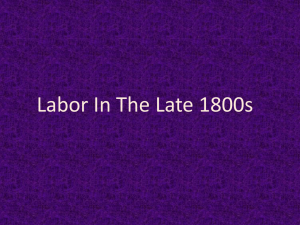this file
advertisement

Use your notes/textbook to copy & define the following for Thursday’s test: John D. Rockefeller corporation Thomas Edison sweatshop monopoly mass production Andrew Carnegie Knights of Labor entrepreneur Homestead Strike You will only have 10 minutes to do this. Then we will be moving on! Copy & ANSWER the following for tomorrow’s test: -Which system involves combining many firms in the same business? -The federal government formed the Interstate Commerce Commission to ? -True/false: In the late 1800s, industrial workers struggled to survive -Which labor union focused on specific crafts & trades for skilled workers? -How did establishing a monopoly help a corporation increase profits? -Eugene Debs was arrested at which strike? You will only have 10 minutes to Do this. Then we will be moving on! -True/false: “laissez faire” means “hands off” -Bessemer process -the ICC -Sherman Antitrust Act -vertical & horizontal integration -collective bargaining -How did establishing a monopoly help a corporation increase profits? -Why did many call industrial leaders, like Carnegie & Rockefeller, “Captains of Industry” or “Robber Barons”? (explain both) -Name two ways that the federal government tried to regulate business in the late 1800s. Do you think these regulations were effective? Explain your 6.3 Organized Labor After 1865 Terence V. Powderly – the leader of the Knights of Labor, encouraged boycotts & negotiations w/employers Samuel Gompers – a poor English immigrant who formed the American Federation of Labor, a skilled workers union, in 1886 Objectives • Assess the problems that workers faced in the late 1800s. • Compare the goals and strategies of different labor organizations. • Analyze the causes and effects of strikes. • sweatshop – small factory where employees have to work long hours under poor conditions • company town – community whose residents rely upon one company for jobs, housing, and shopping • collective bargaining – negotiating as a group for higher wages or better working conditions • socialism – an economic and political philosophy that favors public, instead of private, control of property and income • Knights of Labor – labor union that sought to organize all workers and focused on social reforms • Terence V. Powderly – the leader of the Knights of Labor (beginning in 1891) who encouraged boycotts and negotiations with employers • Samuel Gompers – a poor English immigrant who formed the American Federation of Labor, a skilled workers union, in 1886 • American Federation of Labor (AFL) – American Federation of Labor, a loose organization of skilled workers from many unions devoted to specific crafts or trades • Haymarket Riot – labor protest in Chicago in 1886 that ended in deadly violence • Homestead Strike – 1892 Pennsylvania steelworkers’ strike that resulted in violence between company police and strikers • Eugene V. Debs – leader of the American Railway Union who eventually became a socialist • Pullman Strike – a nationwide strike in 1894 of rail workers that halted railroads and mail delivery How did the rise of labor unions shape relations among workers, big business, & government? The booming American economy relied on workers to fuel its success. They began to rebel against low pay and unsafe working conditions. Struggles between business owners and workers intensified. Industrial workers faced hardships: • Factory owners employed people who would work for low wages. Many of these people were immigrants & children. • They often labored in hot, dark, dirty workhouses known as sweatshops. sweatshop – small factory where employees work long hours in poor conditions • Laborers often had to live in company towns & buy goods at high interest at company stores. company town – community whose residents rely upon one company for jobs, housing, & shopping • collective bargaining – negotiating as a group for higher wages/better working conditions Labor unions formed. Workers tried collective bargaining to gain more power against employers. One form was the strike, in which workers stopped working until their demands were met. Child laborers in 1890 Labor Unions of the Late 1800s Labor Union Industry and Activity • Knights of Labor American Federation of Labor (AFL) American Railway Union (ARU) • • • • • • • • Organize ALL workers Focused on social reform Terence V. Powderly-encouraged boycotts & negotiation. included SKILLED workers focused on specific crafts/trades founded by Samuel Gompers rail workers conducted the Pullman Strike of 1894 Eugene Debs • socialism – an economic & political philosophy favoring public, instead of private, control of property & income. spread through Europe in the 1830s. It held that wealth should be distributed equally to everyone .Most Americans rejected socialism, but some labor activists borrowed ideas from it to support social reform. • Samuel Gompers – a poor English immigrant who formed the American Federation of Labor, a skilled workers union, in 1886 As membership in unions grew in the In 1877 the federal 1870s, a wave of government sent in confrontations troops to restore between labor & management rocked the country. order after a major strike by railroad workers. Across the nation, workers mounted demonstrations for more rights. One such protest in Chicago turned violent. Haymarket Riot – labor protest in Chicago in 1886 that ended in deadly violence. This made many Americans wary of labor unions. Homestead Strike – 1892 Pennsylvania steelworkers’ strike, resulted in violence between company police & strikers of Carnegie Steel. "Nothing...in all my life, before or since, wounded me so deeply," Carnegie wrote in his autobiography. "No pangs remain of any wound received in my business career save that of Homestead." Pullman Strike halted nationwide railroad traffic & mail delivery, 1893, led by Eugene V. Debs – leader of the American Railway Union who eventually became a socialist The government ordered strike organizers to end the strike. Debs refused and was sent to jail. Troops were called in to end the strike. Effects on the Labor Movement • Employers successfully appealed for court orders against unions. • Contract disputes and strikes continued to occur as American industry grew. • The labor movement split into different factions. Debs helped organize the American Socialist Party and the Industrial Workers of the World.








